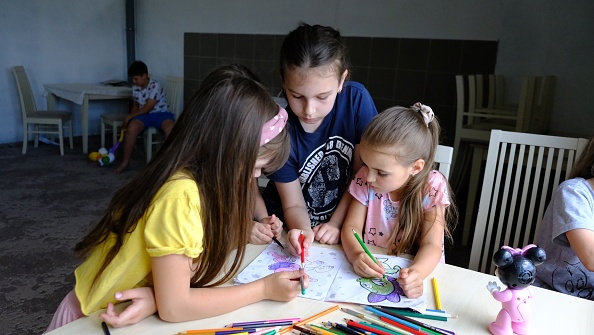Why we need to pay attention to the mental health of children and caregivers
This tipsheet was drawn from the first webinar in a series focused on Early Childhood Reporting, part of the Dart Center’s Early Childhood Initiative.

DNIPRO, UKRAINE - JUNE 20: Ukrainian children are seen at a refugee camp's school in Dnipro, Ukraine on June 20, 2022. In the Ukraine-Russia War, the children of Ukrainian who left their city and migrated to Dnipro, continue their lives here. (Photo by Abdullah Unver/Anadolu Agency via Getty Images)
This tipsheet was drawn from the first webinar in a series focused on Early Childhood Reporting, part of the Dart Center’s Early Childhood Initiative. The webinar was moderated by Irene Caselli, and the speakers were:
Tanmoy Goswami, mental health journalist and founder, Sanity by Tanmoy, India
Chandra Ghosh Ippen, child trauma psychologist and associate director, Child Trauma Research Program at University of California, San Francisco, USA
Anya Kamenetz, education reporter, NPR, USA
Understand the basics of trauma. Make children feel they are part of the story-telling process. Don’t frame the story from an adult’s perspective. Protect identities.
Understand how exposure to trauma can impact children
Young children tend to believe that adults can keep them safe from danger. That is a core aspect of attachment theory. When this belief is shattered, children may experience a sense of being stranded by those who they feel should have protected them. Journalists should be aware of this. They should also consider that, as adults, children might perceive them to be part of the group that hasn’t protected them.
Make children feel they are part of the story-making process
First, explain simply to children why you’re seeking to tell their story. And try to make them feel like they’re partners in that process.
One tactic is to use open-ended “wonder” questions. For example, if you are talking to a child from a refugee background, you could ask: I know you came from a far away place. I wonder what that feels like?
A “wonder” isn’t a demand. It allows children to think and to collaborate.
Monitor physical symptoms during an interview
Ensure the pace and length of interviews reflects the age of the child you’re interviewing. Young children require shorter, bitesize interviews, and if they appear distracted, or wander off mid-way through the conversation, you should pause. This doesn’t mean they won’t come back, but you should allow them this time to regulate before returning.
Get to know them outside the prism of tragedy
As with all interview subjects, young children are more than the sum of the bad things that have happened to them. Take care to find out who they are beyond the trauma they have experienced. What games do they like to play? What animates them? Ask them, and their caregivers, what makes them laugh. Find out what their coping mechanisms are. Start and end interviews with a positive note.
Avoid framing the story from an adult’s perspective
Often, stories about children are told from the perspective of adults. While it’s useful to gain and include the views of caregivers, try to lead with the experiences and feelings of a child.
Protect their identity
Even if a child or their caregiver gives informed consent for their name and image to be used, they might come to regret this when they are older. Young people have a right to be forgotten, and so consider using only first names as a default when reporting on children, and think about how images or voice recordings could allow for some anonymity.
These webinars were made possible by support from the Bernard van Leer Foundation (Netherlands), the Maria Cecilia Souto Vidigal Foundation (Brazil), and The Two Lilies Fund (United States).
































































































